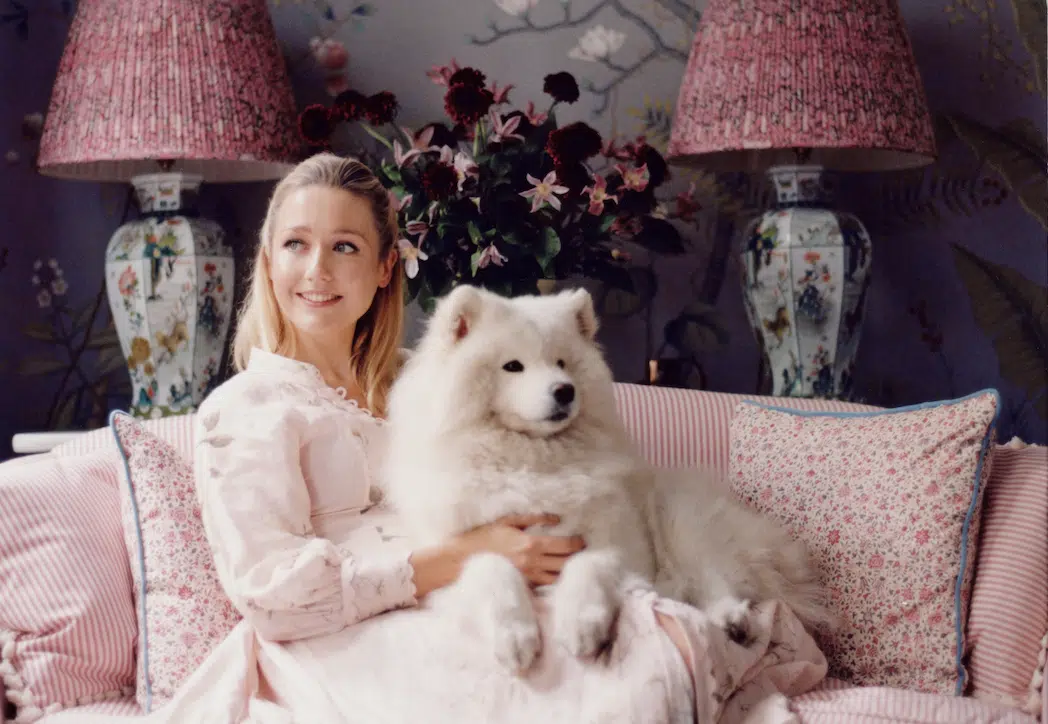Founded in 1986 by Claud Cecil Gurney in his search for artisans who could restore antique wallpaper using traditional techniques, de Gournay’s hand-painted and hand-embroidered wallpapers remind us of grand frescoes full of narrative and natural beauty. de Gournay’s one-of-a-kind wallpapers are created by teams of artists and artisans working together to create intricate and expressive works. Throughout the history of the company, de Gournay has shared a long love affair with India, often utilising Mughal motifs and local crafts, in a catalogue full of global inspirations and styles ranging from Chinoiserie and Chinese porcelain to Art Nouveau and Art Deco.
Here, we speak to Director Hannah Cecil Gurney to find out more about the company’s history, creative process and inspirations.
How did de Gournay come about?
My father founded de Gournay with the aim of providing people access to true beauty within their homes. He wanted to show how after a long day amidst the strains and stresses of the world, they could return and rest with a hand painted garden. They could, through our creations, enjoy colour and vitality, even in the heart of the busiest city. That our scenes are hand painted and hand embroidered does not make them any less effective than the real thing.
What role does craft play at de Gournay?
Every wallpaper made by de Gournay is created entirely by hand, and it is this ‘spirit resonance’ – the visible presence left by the artist – that defines our craft. From the sparest composition to the densest scenes, each order uses historic techniques unchanged for hundreds of years.
 de Gournay handmade ‘Deco Dawn’ design wallpaper on deep rich gold gilded paper. Image credit: Alexandra Shamis and courtesy of de Gournay.
de Gournay handmade ‘Deco Dawn’ design wallpaper on deep rich gold gilded paper. Image credit: Alexandra Shamis and courtesy of de Gournay.
In a recent collection, certain de Gournay fabrics were hand-embroidered in Kolkata. How did that come together?
India’s illustrious history of embroidered crafts has long been a source of rich inspiration for us, and is complementary to our hand painted designs. We knew that the techniques and methodologies from this region could not be imitated, and that it would be imperative to source artisans with the necessary skills. Our efforts were not in vain, and the assembled team embody the very best of these rare abilities.
With a roster of more than 300 artists, each with their own unique voices, how does collaboration work at de Gournay?
Every de Gournay project is a collaboration. Whether it is four panels for a cloakroom, or 40 panels for a hotel salon, each is born from scratch, and must be developed through close attention to backgrounds, colours and composition. We make our products by hand and can create wholly unique designs; we can also customise them from our permanent collections. In each instance, something is being made for you and is tailored to your walls. It’s a bespoke service — much like a Savile Row suit or an Haute Couture dress.
“Every wallpaper made by de Gournay is created entirely by hand, and it is this ‘spirit resonance’ – the visible presence left by the artist – that defines our craft.”
The artists at de Gournay seem comfortable exploring multiple aesthetics and art movements, but are some styles more popular than others?
I think it’s natural to see trends come and go, even on a broader scale. What is interesting about de Gournay is that our designs are based on much older styles than most brands, the popularity of which has not waned. History has proven them both wonderfully classic but wholly open to contemporary interpretation.
How have you seen the audience’s tastes evolve over time?
I think my father would feel the demand for our designs is far more widespread than when he started. Many of his original clients were enthusiasts with historic houses of their own. These would have maybe one room with a hand painted Chinese wallpaper. It was an exciting but very niche venture. But now, the appeal has really grown. I see these same kinds of wallpapers being acquired by young couples for their urban flats in cities like Berlin, for instance.
Motifs from the natural world are prevalent in your work. Tell us more about where your journey of referencing and inspiration begins.
Nature is good for the soul – it’s a fact – and our designs celebrate that. Moreover, many of the motifs from our standard collections reference existing wallpapers within historic houses: so in many cases, it’s an interesting balance between nature and a stylised interpretation. This gives the motifs a distinct energy.
Please tell us a bit about your work in porcelain.
We have our own porcelain studio in Jingdezhen, where the historic kilns of the imperial dynasties were located. It’s a lesser-known arm of our repertoire, but one still entirely dedicated to centuries old craft. Until now we had focused mainly on more traditional pieces, such as dinner services, but we are increasingly looking to expand to items more engaging to a younger market. Watch this space!
de Gournay designs appeared on the digital stationery app HiNOTE in a 2023 collaboration. What opportunities do you see with technology in the future?
The typical answer would of course be to one day see hand painted wallpaper that moves upon the walls, but I think tech is harder to predict in that way. HiNOTE was a lovely way to create something decorative, but I wonder whether the divide between tech and craft might in fact be greater in future.
Who are the voices in interior design currently inspiring you?
It’s so hard to choose just one. Nothing gives me greater pleasure than seeing how designers interpret our wallpapers and fabrics!
de Gournay was founded in 1986 by Claud Cecil Gurney. Their work will be part of India Art Fair’s inaugural Design section at the 2024 edition, along with other pioneers in the field.


